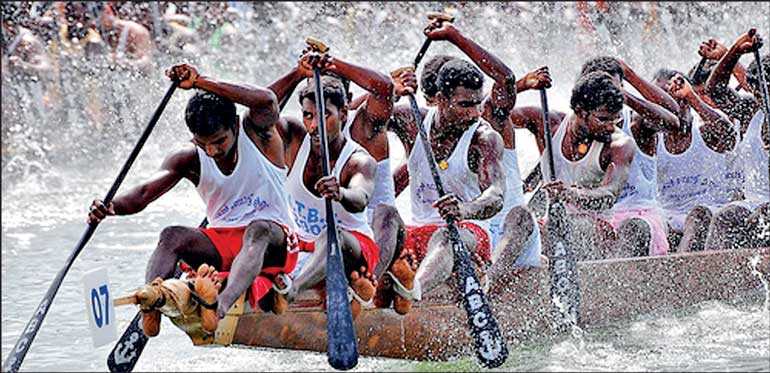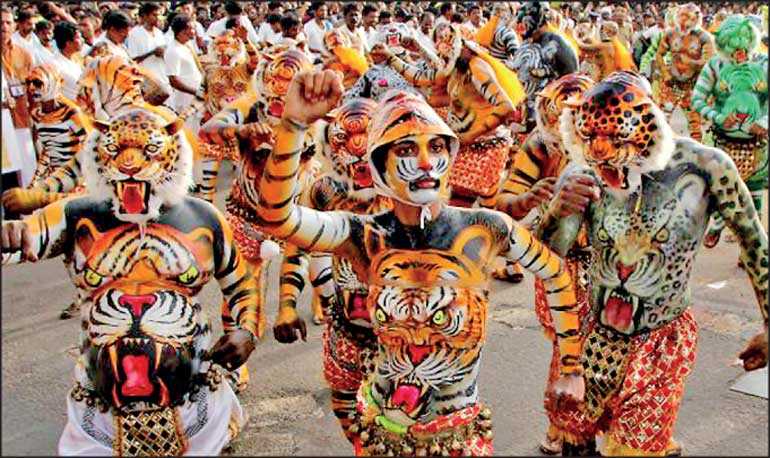Thursday Apr 25, 2024
Thursday Apr 25, 2024
Saturday, 5 September 2020 00:10 - - {{hitsCtrl.values.hits}}

Vishnu
A brilliant sun with its golden beams caresses the lush green landscape; the blooming flowers scattered all around imitate a starlit sky; the clouds play hide and seek with the people who engage in playful activities of the festival; wearing new attire, making intricate floral carpets, dancing and appealing to the mythical King Mahabali for his annual sojourn in his old kingdom; a kingdom where all people were equal, happiness everywhere without fear of death or calamities. This is the concept of Onam.
The myth or the legend of Onam might be a creation of a poetic mind; but it gives the people hope; a dream to cherish. This dream pushes people to work for a society where all people are equal in their rights without any bias of regions or religions.
‘When Mahabali, the King, rules the land,
All the peoples form one casteless race
And people live joyful and merry;
They are free from all harm
There is neither theft nor deceit,
And no one is false in speech either.
Measures and weights are right;
No one cheats or wrongs the neighbor.
When Mahabali, our King, rules the land
All the peoples form one casteless race’,
The age-old folk song, quoted above, is one of the traditional songs of the festival.
The legend of Onam:
 The King Mahabali, a just and benevolent asura king who ruled the kingdom of Kerala and during his reign, everyone lived in prosperity enjoying lives cheerfully and had a complete state of welfare. There were no class or caste discrimination or thieveries, and equality and honesty prevailed throughout the land. Since the King’s popularity grew to the extent that even it made the Gods jealous thinking that the subjects of Mahabali will be more devoted to him than to any of the deities! All the devas in heaven approached Lord Vishnu to relieve them from this anxiety and concern.
The King Mahabali, a just and benevolent asura king who ruled the kingdom of Kerala and during his reign, everyone lived in prosperity enjoying lives cheerfully and had a complete state of welfare. There were no class or caste discrimination or thieveries, and equality and honesty prevailed throughout the land. Since the King’s popularity grew to the extent that even it made the Gods jealous thinking that the subjects of Mahabali will be more devoted to him than to any of the deities! All the devas in heaven approached Lord Vishnu to relieve them from this anxiety and concern.
Vishnu, one of the three principal gods of Hinduism, took different forms or avatars in various ages, to subjugate the human pride and unbecoming of nature that might dethrone the deities of their power. In this story, knowing the benevolent character of the King Mahabali, Vishnu took the form of Vamana, a short heighted Brahmin, and approached the king to beg a piece of land. Though, Mahabali understood that the person in the guise of a Brahman was none other than Vishnu himself and came only to dethrone him, the king did not want to change his character of benevolence and granted Vamana as much land as he needed. Vamana told the king that he needed only three steps of land as per the measure of his foot. As soon as the King agreed to it, Vamana grew in cosmic proportions. With his first step, Vamana covered the world, and with the second, he covered the whole of the skies. As there was nothing more to be conquered, Vamana asked for a space for his third step to Bali. With folded hands, Mahabali knelt in front of Vamana, whom he knew was not an ordinary man and came only to subjugate him, to place his last step upon his head so that he could keep his promise.
Vishnu, in the form of Vamana, placed his foot on the head of the King, and pushed him down to Patala, the netherworld. However, pleased with the King’s generosity, Vishnu granted him a boon, to which Mahabali requested to allow him to visit his land and his people once every year for three days. Onam, thus is the celebration of the homecoming of Mahabali every year for the Keralites.
The festival reminds people of the greatness of ‘giving’ rather than ‘taking’. The arrival of King Mahabali heralds the idea of a just and welfare society. The entire Kerala blooms at this time of every year as a celebration of the homecoming of the Asura King. To welcome him flowers are picked and arranged in front of homes in colorful and intricate patterns called Pookalam. The most important flower for welcoming Mahabali, on the day, is Thumbappoo known as Ceylon Slitwort.
 Vallamkali
Vallamkali
A feast is also held in every home – with an open invitation for King Mahabali to come and have the feast with them. The King visits Kerala on the tenth day from the beginning of the festival. On Thiruvonam day, Mahabali visits all over Kerala, and the festivities continue for the next two days.
Though the legend relates the celebration of Onam to Hinduism, the spirit of the festival is about common well-being where equality and love prevail. The Muslim and Christian communities of Kerala hail it wholeheartedly and participate in all the festivities. Onam falls in the month of Chingam; the first month of the lunar calendar followed in Kerala, is a harvest season. The previous month or the last month of the Malayalam calendar is of the lashing rains of monsoon. It is also a season of scarcities and difficulties. But the new year is full of hope, and bright sun and flowers.

Festivities
The festivities that galore the days of Onam are spectacular and diverse. Making of pookalam (floral patterning), Pulikali (a folk dance in which artists paint their bodies like a leopard with stripes of yellow, red and black and dance to the rhythm of traditional percussion instruments, Thiruvathirakali (the traditional dance of women in Kerala), Kummattikkali (a colourful mask-dance similar to the Kola Sanniya of Sri Lanka), Onasadaya (a large vegetarian feast served on banana leaves with rice and up to 24 side dishes), playing Onavillu (a musical instrument in the form of a bow, playing on swings, tug of war and so on are the most popular games.
If such games are homely ones, Vallamkali, the snake boat race, with the very long snake-shaped boats and several other kinds of boats participating, adds colour and rhythm to the celebrations as a group activity and spectacle. It’s no wonder that the boat race has become a major part of the festival in a land which has more than 44 rivers, five back waters and 580 kilometres long coast line. From region to region, the games change, but the spirit remains the same.
As the people of Kerala travelled and lived overseas for various endeavours, they spread the message of Onam everywhere with the same gaiety, fervor and festivities.
The first of this kind of Onam celebrations by the Keralites staying outside Kerala was reported to have been held in 1883 in the Madras Presidency organised by the Tropical Malayali Literary Association. Later in Rangoon, Sri Lanka, Singapore, London, many of the Gulf countries and New Zealand.
It is worthy to note that Onam is not just a celebration of a golden past. Instead, it is a hope for the future taking cue and energy from the past. For which, flowers are laid everywhere believing they are the beautiful, fragrant, loveable witnesses of the oncoming of a better society on earth.